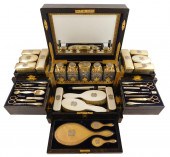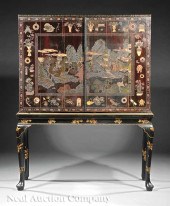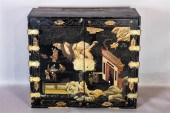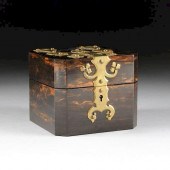Pricing Guides & Dictionary of Makers Marks for Antiques & Collectibles

ANTIQUE AND COLLECTIBLE COROMANDEL:
A Timeless Beauty
Join the most updated and complete collectibles research online - Learn more...
 Coromandel, also known as calamander, is a rare and exotic hardwood native to Southeast Asia. It has been highly valued for centuries due to its striking black and brown striped pattern, as well as its durability and resistance to insects and rot. In the 18th and 19th centuries, coromandel was used extensively in the production of fine furniture, decorative objects, and musical instruments. Today, antique and collectible coromandel items continue to captivate collectors and enthusiasts alike.
Coromandel, also known as calamander, is a rare and exotic hardwood native to Southeast Asia. It has been highly valued for centuries due to its striking black and brown striped pattern, as well as its durability and resistance to insects and rot. In the 18th and 19th centuries, coromandel was used extensively in the production of fine furniture, decorative objects, and musical instruments. Today, antique and collectible coromandel items continue to captivate collectors and enthusiasts alike.
History and Origin of Coromandel
Coromandel wood comes from the Diospyros quaesita tree, which is native to Sri Lanka and Southeast Asia. The tree is slow-growing and typically reaches a height of 60-70 feet. The wood is harvested from the heartwood of the tree, which is the central, darker portion of the trunk.
The name coromandel comes from the Coromandel Coast of India, where the wood was traded and shipped from during the 18th and 19th centuries. The wood was highly sought after by European traders and craftsmen due to its distinctive appearance and durability.
Uses of Coromandel in Antiques and Collectibles
Coromandel wood has been used in the production of a wide variety of antique and collectible items, including furniture, jewelry boxes, tea caddies, and writing slopes. In the 18th and 19th centuries, coromandel was particularly popular for use in the production of luxurious and ornate furniture, such as cabinets, desks, and tables.
One of the most famous uses of coromandel wood is in the production of musical instruments. Many high-end pianos and violins from the 19th century were constructed using coromandel, due to its tonal properties and durability.
Today, antique and collectible coromandel items are highly sought after by collectors and enthusiasts for their beauty, rarity, and historical significance.
Collecting Coromandel
Collecting coromandel can be a rewarding and fascinating hobby for those with an interest in antique and decorative arts. Here are some tips for starting and building a coromandel collection:
- Research and Education - Before starting a coromandel collection, it is important to educate oneself on the history, characteristics, and value of coromandel items. This can be done through reading books, attending auctions and exhibitions, and consulting with experts in the field.
- Quality over Quantity - When building a coromandel collection, it is important to focus on quality over quantity. Look for pieces that are in good condition, with minimal damage or restoration. Consider factors such as rarity, provenance, and historical significance when evaluating potential acquisitions.
Caring for Coromandel
Proper care and maintenance are essential for preserving the beauty and value of antique and collectible coromandel items. Here are some tips for caring for coromandel:
- Avoid Direct Sunlight - Direct sunlight can cause the color and finish of coromandel to fade over time. Keep coromandel items out of direct sunlight and away from windows or other sources of UV light.
- Regular Cleaning - Regular cleaning is important for keeping coromandel items looking their best. Use a soft, dry cloth to gently remove dust and debris. Avoid using water or harsh cleaning products, which can damage the wood and finish.
Conclusion
Antique and collectible coromandel is a timeless beauty that has been treasured for centuries. Its unique pattern and durability make it a sought-after material for antique furniture, musical instruments, and decorative arts. Collecting coromandel can be a rewarding hobby for those with an interest in antique and decorative arts. However, it is important to research and educate oneself on the history and characteristics of coromandel before starting a collection. Quality over quantity is also important when building a coromandel collection.
Proper care and maintenance are essential for preserving the beauty and value of antique and collectible coromandel items. Direct sunlight should be avoided, and regular cleaning should be performed using a soft, dry cloth.
In conclusion, coromandel wood is a rare and exotic material that has been valued for centuries. Its use in antique and collectible items continues to captivate collectors and enthusiasts around the world. By educating oneself on the history and characteristics of coromandel and properly caring for coromandel items, one can enjoy the beauty and historical significance of this timeless material for years to come.
Unlock the true value of your collection with our comprehensive research guides from identifying makers' marks to appraising all kinds of antiques and collectibles, including items featured in this article.
Our up-to-date information will give you an accurate understanding of your items' worth. Don't miss out on this valuable resource - visit our research tools today!
In addition to some examples shown below on this page, you can also search our price guide for your own treasures.
Examples of related items from our Price Guides
-
 ENGLISH COROMANDEL NéCESSAIRE DE VOYAGE
[more like this]
ENGLISH COROMANDEL NéCESSAIRE DE VOYAGE
[more like this]
-
 A Good English "Coromandel" Carved and L
[more like this]
A Good English "Coromandel" Carved and L
[more like this]
-
 A CHINESE COROMANDEL BLACK LACQUER TWELV
[more like this]
A CHINESE COROMANDEL BLACK LACQUER TWELV
[more like this]
-
 GEORGE III COROMANDEL AND BLACK PAINTED
[more like this]
GEORGE III COROMANDEL AND BLACK PAINTED
[more like this]
-
 A VICTORIAN FITTED COROMANDEL TRAVELING
[more like this]
A VICTORIAN FITTED COROMANDEL TRAVELING
[more like this]
-
 COROMANDEL CANE 19TH CENTURY LENGTH 37".
[more like this]
COROMANDEL CANE 19TH CENTURY LENGTH 37".
[more like this]
-
 VICTORIAN COROMANDEL DRESSING BOX<br>Vic
[more like this]
VICTORIAN COROMANDEL DRESSING BOX<br>Vic
[more like this]
-
 Pair of Chinese Coromandel Sidechairs,
[more like this]
Pair of Chinese Coromandel Sidechairs,
[more like this]
-
 Dutch School (Late 19th Century) "St. T
[more like this]
Dutch School (Late 19th Century) "St. T
[more like this]
-
 A Coromandel Wood Jewelry Chest with Met
[more like this]
A Coromandel Wood Jewelry Chest with Met
[more like this]
-
 ANTIQUE COROMANDEL 8 PANEL SCREEN Antiqu
[more like this]
ANTIQUE COROMANDEL 8 PANEL SCREEN Antiqu
[more like this]
-
 ORIENTAL CARVED HARDWOOD FLOOR SCREEN Or
[more like this]
ORIENTAL CARVED HARDWOOD FLOOR SCREEN Or
[more like this]
There are many more auction results available to our members...





